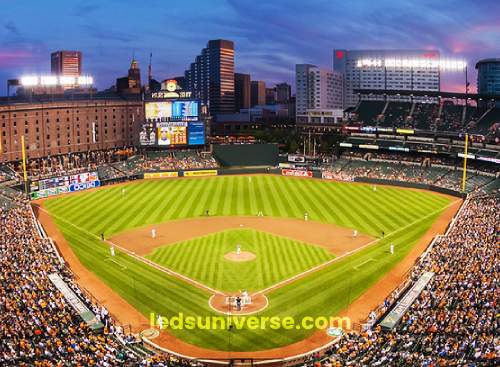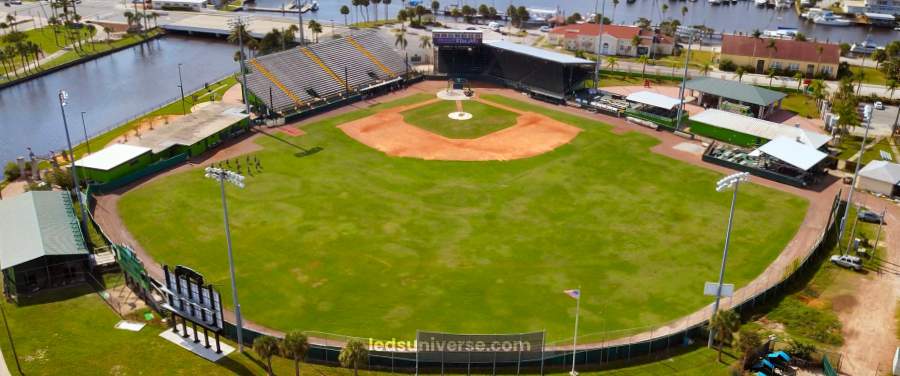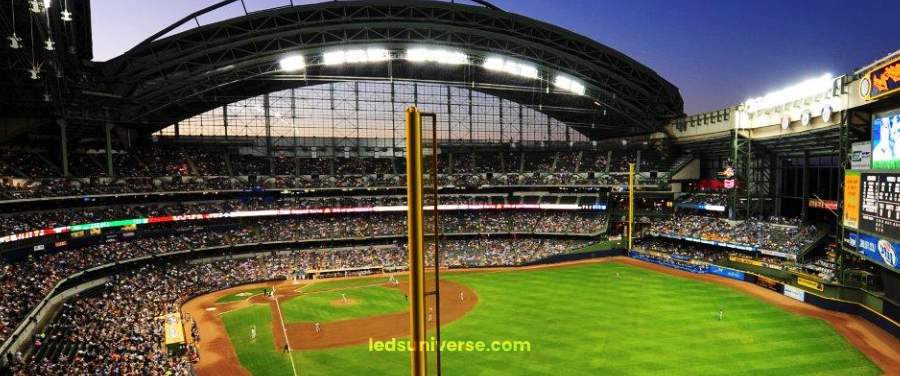Lighting is the unsung hero of baseball, turning night into day and ensuring every pitch, swing, and catch is seen with crystal clarity. Whether under the bright lights of a professional stadium or at a local park, the right lighting can transform the game. From the glow that fills the field to the shadows it prevents, a well-designed lighting system enhances the experience for players and fans alike, ensuring the game shines at its best, no matter the hour.
As evening games become more common and the demands for high-quality play increase, understanding the nuances of baseball field lighting becomes essential. This guide explores the key aspects of baseball field lighting, including the technical requirements, various types of lighting, optimal pole arrangements, and associated costs. By delving into these components, field owners and planners can make informed decisions to create a well-lit environment that enhances both player performance and spectator enjoyment.
Reach out for free lighting consultation
Table of Contents
Toggle
Lux levels, or illuminance, play a crucial role in ensuring adequate visibility on a baseball field. This measurement quantifies the amount of light reaching a given area, which directly impacts the clarity of the game for players and spectators. For baseball fields, the required lux levels can vary significantly depending on the level of play and the intended use of the field.
In professional settings, such as Major League Baseball (MLB) games, lux levels are typically high, ranging from 1500 to 2000 lux. This high level of illumination is necessary to meet the rigorous demands of high-speed play and high-definition broadcasting. Such brightness ensures that every detail of the game, from the movement of the ball to the expressions of the players, is clearly visible both on the field and through television cameras.
For lower levels of competition, such as college or high school games, the required lux levels are generally lower, falling between 500 and 1000 lux. While this level of lighting may not meet professional standards, it is sufficient to support the needs of amateur players and provide an adequate viewing experience for spectators. Proper lux levels at these levels are essential for player safety, performance, and the overall enjoyment of the game, albeit with less intense lighting compared to professional venues.
| Level of Play | Required Lux Levels | Purpose |
|---|---|---|
| Professional (MLB) | 1500 – 2000 lux | Ensures high visibility for fast-paced play and high-definition broadcasts, highlighting all game details. |
| College/High School | 500 – 1000 lux | Adequate for amateur competition, focusing on player safety, performance, and spectator enjoyment. |
| Training/Practice Fields | 200 – 500 lux | Sufficient lighting for player drills, practice, and training sessions, witho |
Uniformity in lighting refers to the evenness of light distribution across the entire playing field. This aspect of lighting is critical for ensuring that there are no significant variations in light intensity, which could result in dark spots or overly bright areas on the field. Such inconsistencies can hinder players’ ability to track the ball and make accurate plays, thereby affecting the fairness and flow of the game.
To achieve high uniformity, the lighting system should aim for a uniformity ratio where the minimum light level is at least 0.7 times the average light level across the field. This ratio helps ensure that the light distribution is consistent, reducing the likelihood of shadows or overly bright patches that can distract or impair players’ vision. High uniformity is particularly important for maintaining a level playing field and enhancing the overall safety and enjoyment of the game.
Color temperature, measured in Kelvins (K), describes the hue of the light emitted by the fixtures and can significantly impact visibility and comfort. For baseball fields, a color temperature range of approximately 4000K to 5000K is generally preferred. This range provides a bright, white light that closely resembles natural daylight. Such lighting conditions help reduce eye strain and enhance the contrast between the ball and the background, making it easier for players to see and react to fast-moving objects.
Lower color temperatures, which produce warmer, yellowish light, are less ideal for night games. This warmer light can distort color perception and reduce the contrast needed for high-visibility sports. Therefore, maintaining the right color temperature is crucial for ensuring optimal visibility and player performance during evening games.
Glare occurs when intense light directly enters the eyes, causing discomfort and reducing visibility. Effective baseball field lighting should be designed to minimize glare, which can be disruptive for both players and spectators. Proper glare control involves using lighting fixtures with advanced optical designs and appropriate shielding to direct light where it is needed and avoid shining directly into players’ or viewers’ eyes.
The positioning of light fixtures also plays a significant role in managing glare. By carefully positioning and angling the fixtures, it is possible to reduce direct light exposure and ensure that the light is evenly distributed across the field. Minimizing glare enhances the viewing experience, helps players focus on the game, and contributes to overall safety. Proper glare control is essential for creating a comfortable and effective lighting environment, ensuring that everyone involved can enjoy the game without distraction.

LED lighting has become the preferred choice for modern baseball fields due to its numerous advantages. LED lights offer high efficiency, long lifespan, and low maintenance costs. They provide excellent brightness and uniformity, and their adjustable features allow for precise control over light distribution. Additionally, LEDs are highly energy-efficient, reducing electricity costs and environmental impact.
Metal halide lights have been a traditional choice for sports lighting due to their bright, crisp light and good color rendering. They are less energy-efficient than LEDs and have a shorter lifespan, often requiring more frequent replacement. Despite these drawbacks, metal halide lights are still used in many fields due to their initial lower cost and well-established performance characteristics.
Mercury vapor lights are less commonly used today but were once a standard choice for outdoor lighting. They offer a bluish light with good brightness but are less efficient and have a shorter lifespan compared to modern options. Additionally, they contain mercury, which requires careful disposal and poses environmental concerns.
High-pressure sodium (HPS) lights provide a warm, yellowish light that is highly efficient. While they are less effective for color rendering and visibility compared to LED or metal halide lights, they are still used in some baseball fields due to their low operational cost. However, their color temperature is not ideal for high-visibility sports applications.
The arrangement of light poles is a fundamental aspect of designing an effective lighting system for baseball fields. Proper placement and configuration of these poles are essential to achieving uniform illumination and minimizing shadows, ensuring a fair and enjoyable game for players and a clear view for spectators.
For optimal lighting, light poles are generally positioned around the perimeter of the baseball field. This strategic placement ensures that the entire playing area is covered and that light is distributed evenly across the field. In smaller fields or recreational leagues, the light poles are commonly placed at the corners and along the sides of the field. This arrangement can provide adequate lighting for less demanding games, ensuring that the field is well-illuminated without excessive complexity or cost.
In contrast, larger fields or those used for more competitive levels of play, such as college or professional games, require more sophisticated lighting arrangements. For these fields, light poles are often set up in a staggered or grid pattern. This configuration allows for more comprehensive illumination, covering the field more effectively and reducing the risk of dark spots. Staggered placement also helps to ensure that the light is evenly distributed across the entire playing area, enhancing visibility and player performance.
The height of the light poles is another critical factor in the effectiveness of the lighting system. Taller poles, typically ranging from 70 to 100 feet, are commonly used in larger or more advanced fields. The increased height helps to minimize shadows and ensures that light reaches all areas of the field, including the outfield and the pitcher’s mound. Taller poles also allow for a broader spread of light, reducing the need for multiple fixtures and simplifying the overall lighting setup.
For smaller or less demanding fields, shorter poles may be sufficient. However, even in these cases, careful consideration of pole height is important to ensure that the light coverage is adequate and that shadows are minimized. The height of the poles should be matched to the specific requirements of the field, taking into account factors such as field size, the level of play, and the desired lighting quality.
In addition to basic placement and height considerations, advanced lighting systems may incorporate features such as adjustable fixtures and automated controls. Adjustable fixtures allow for fine-tuning of light direction and intensity, which can be particularly useful for accommodating different types of games or events. Automated controls can help to manage lighting levels and reduce energy consumption by adjusting the brightness based on the time of day or specific requirements of the game.

The cost of installing baseball field lighting can vary significantly based on several factors. Key considerations include the type of lighting system, the size of the field, the height and number of light poles, and the complexity of the installation. LED systems generally have a higher initial cost but offer lower long-term operational expenses due to their energy efficiency and longevity. In contrast, traditional lighting systems like metal halide or high-pressure sodium lights may have lower upfront costs but higher ongoing maintenance and energy costs.
Additional costs may include electrical work, mounting equipment, and any necessary upgrades to the existing infrastructure. It is also important to consider the costs associated with meeting local regulations and safety standards.
The cost of lighting a baseball field can vary based on the level of competition and the specific requirements of the lighting system. Below is a table outlining the average costs for different levels of play:
| Level of Competition | Average Cost (USD) |
|---|---|
| Recreational | $30,000 – $50,000 |
| High School | $50,000 – $80,000 |
| College | $80,000 – $150,000 |
| Professional | $150,000 – $300,000 |
Recreational fields typically have simpler lighting systems with fewer poles and lower lux levels, resulting in lower costs. High school fields require more advanced systems with higher brightness and uniformity, leading to higher expenses. College and professional fields demand the highest standards of lighting, including extensive coverage and advanced features, contributing to their higher costs.
A well-maintained lighting system ensures consistent performance, safety, and energy efficiency over time. Additionally, staying informed about advancements in lighting technology can provide opportunities to enhance the system’s effectiveness and reduce long-term costs.
Regular maintenance is crucial for ensuring that a baseball field’s lighting system continues to meet performance standards. Over time, light fixtures may lose brightness due to dirt buildup, wear and tear, or natural aging of the bulbs. Routine inspections and cleanings help to maintain optimal light output, preventing uneven illumination and dark spots that can affect gameplay.
In addition to cleaning, replacing aging or malfunctioning bulbs and components is an important aspect of maintenance. Traditional lighting systems, such as metal halide or mercury vapor fixtures, may require more frequent bulb replacements compared to modern LED systems. With LED technology, the maintenance burden is significantly reduced due to their long lifespan, but even LED fixtures should be checked periodically to ensure all components are functioning correctly.
Electrical components, such as wiring and transformers, also need to be inspected regularly to avoid potential issues like power surges or system failures. By addressing small problems early, field operators can prevent larger, more expensive repairs and ensure the lighting system remains reliable.
Technological advancements in sports lighting continue to offer more efficient and effective solutions for baseball fields. As lighting technology evolves, it’s important to stay updated on these developments to take advantage of improved energy efficiency, lighting quality, and control options.
For example, many older baseball fields were originally outfitted with metal halide or mercury vapor lights. While effective in their time, these systems are now being outclassed by LED lighting, which offers superior energy efficiency, better light quality, and longer operational life. Upgrading to an LED system can reduce energy consumption by up to 70%, resulting in significant savings on electricity bills over time. Additionally, the longer lifespan of LEDs minimizes the need for frequent replacements, further reducing maintenance costs.
Modern lighting systems also offer advanced control options, such as programmable lighting schedules, remote monitoring, and dimming capabilities. These features allow for greater flexibility in managing the field’s lighting, whether adjusting brightness levels for different events or automating lights to turn off when not needed. Such systems can also integrate with smart grid technology to further optimize energy usage.
When planning for future upgrades, it’s essential to evaluate the long-term return on investment. While the upfront costs of upgrading to a new system, especially an LED system, may be significant, the savings in energy and maintenance costs often make it a financially sound decision in the long run. Additionally, many municipalities and sports organizations offer grants or incentives for upgrading to energy-efficient lighting systems, further offsetting the cost.
Another aspect to consider in the planning phase is ensuring that the lighting system complies with local regulations and environmental standards. Many regions have specific guidelines regarding light pollution and energy consumption, especially for outdoor sports fields in residential or ecologically sensitive areas.
Lighting systems should be designed to minimize light spill and skyglow, which can negatively affect the surrounding community and environment. This can be achieved through the use of advanced optical designs and shielding to focus light precisely where it’s needed—on the field. By reducing light pollution, field operators not only comply with regulations but also create a better viewing experience for players and spectators.
Furthermore, many organizations and governing bodies are increasingly adopting sustainability standards that encourage the use of energy-efficient lighting and environmentally friendly materials. Upgrading to energy-efficient systems, such as LED lighting, not only aligns with these sustainability goals but also helps to lower the carbon footprint of the facility, contributing to a greener future.
When designing or upgrading a baseball field lighting system, it’s also important to consider potential future growth. As the needs of the facility change, such as hosting larger or higher-profile events, the demands on the lighting system may increase. By choosing a scalable lighting solution, field operators can easily accommodate changes without needing a complete overhaul of the system.
For instance, installing additional light poles or upgrading to higher-powered fixtures may be necessary if the field begins hosting more competitive levels of play or nighttime events. Building flexibility into the initial design helps to future-proof the facility, ensuring it can meet evolving requirements without excessive cost or disruption.
Key factors like lux levels, uniformity, color temperature, and glare control ensure optimal visibility and game quality. Modern LED lighting offers significant advantages, including energy efficiency, lower maintenance, and enhanced control, making it a preferred choice over older systems. Proper light pole placement and height also play a vital role in even light distribution and minimizing shadows. Regular maintenance, upgrades, and future-proofing are essential for keeping lighting systems efficient and up to date, ensuring the best experience for all levels of play.